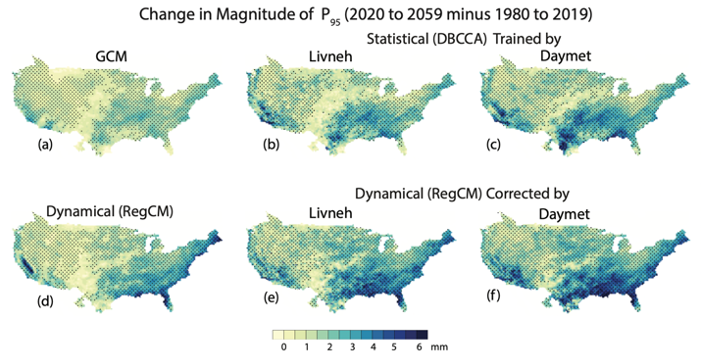Scientific Achievement
We present an intercomparison of a suite of high-resolution downscaled climate projections based on a six-member General Climate Models (GCM) ensemble from the 6th Phase of Coupled Models Intercomparison Project (CMIP6). The CMIP6 GCMs have been downscaled using dynamical and statistical downscaling techniques based on two meteorological reference observations over the conterminous United States (CONUS). To the best of our knowledge, this is the first CONUS-scale intercomparison of multiple CMIP6-based downscaled climate projections in both historical and projected future periods that evaluates the differences arising from the choice of downscaling approaches and meteorologic observations.

Significance and Impact
Investigation of climate change impacts at local to regional scales requires spatially resolved climate projections to sufficiently capture fine-scale responses and feedbacks. Regional climate downscaling using process-based dynamical downscaling, empirical-based statistical downscaling, or a combination of both is generally employed to develop high-resolution climate projections for impact studies. However, the quantitative differences between the outcome of these approaches remain unclear. Therefore, this study investigates how the choice of downscaling techniques, and meteorological reference observations, can affect future hydroclimate responses representing average and extreme states of the Earth system at regional to local scales. The lack of robust understanding of uncertainties in the regional downscaling of future climate projections can be detrimental in the long-term planning to cope with the impacts of climate change. For instance, underestimating regional-scale climate change responses can result in under-preparedness from a planning and mitigation perspective. Contrarily, overestimating these responses may cause overbudgeting to deal with the consequences. These comparative analyses can inform the development of more reliable approaches for future impact assessment and mitigation planning.
The high-resolution downscaled climate output analyzed in this study has been used in various regional scale hydro-climate risk assessment exercises, including but not limited to evaluations of climate change impacts on hydrology, reservoir operations, hydropower generation, future energy demand, and climate extreme events. The multi-model framework provides a new dimension for the impact assessment community to explore the additional uncertainties along the hydroclimate modeling and analysis chain.
Research Details
- We use the regional climate model, RegCM4, for dynamical downscaling, the double bias correction constructed analogues (DBCCA) method for statistical downscaling, and Daymet and Livneh datasets as the reference observations for statistical training and bias-correction.
- The dynamically downscaled RCM exhibits improvements over the driving GCMs in several evaluation metrics but exacerbates biases in a few evaluation metrics. Further, the choice of meteorological reference observation used in the bias-correction of downscaled historical climate output can result in marked differences in the outcome.
- The bias-corrected simulations and/or the statistical downscaling of GCM mostly remove their simulated errors in the historical climates, and these improvements are mostly insensitive to the choice of the downscaling technique.
- The downscaling techniques and reference observations can influence the future hydroclimate response in the downscaled climate projections, stressing the need for a comprehensive understanding of such method-based uncertainties.
Facility
Support for the climate simulations, data storage, and analysis is provided by the Oak Ridge Leadership Computing Facility, which is a DOE Office of Science User Facility.
Publication
Rastogi, D., Kao S.C., & Ashfaq, M. (2022). How May the Choice of Downscaling Techniques and Meteorological Reference Observations Affect Future Hydroclimate Projections? Earth’s Future, 10 (8), https://doi.org/10.1029/2022EF002734
Funding
This study is supported by the U.S. Department of Energy (DOE) Water Power Technologies Office as a part of the SECURE Water Act Section 9505 Assessment.
Summary
High-resolution hydroclimate projections are required to investigate climate change impacts at local to regional scales. While climate downscaling using dynamical and statistical approaches has been commonly used to study climate impacts, the quantitative differences arising from the choice of downscaling technique and reference observations are unclear. To this end, we present an intercomparison of a high-resolution ensemble of climate projections obtained by downscaling the CMIP6 GCMs using process-based dynamical downscaling and subsequent bias correction and empirical-based statistical downscaling using two different reference observations. We find that the choice of downscaling techniques and reference observations can impact the historical outcome and future projections of the downscaled ensembles. The results presented in the study stress the need for a more comprehensive framework to capture the full range of methodological uncertainties in future climate projections.




